Humming Blog |
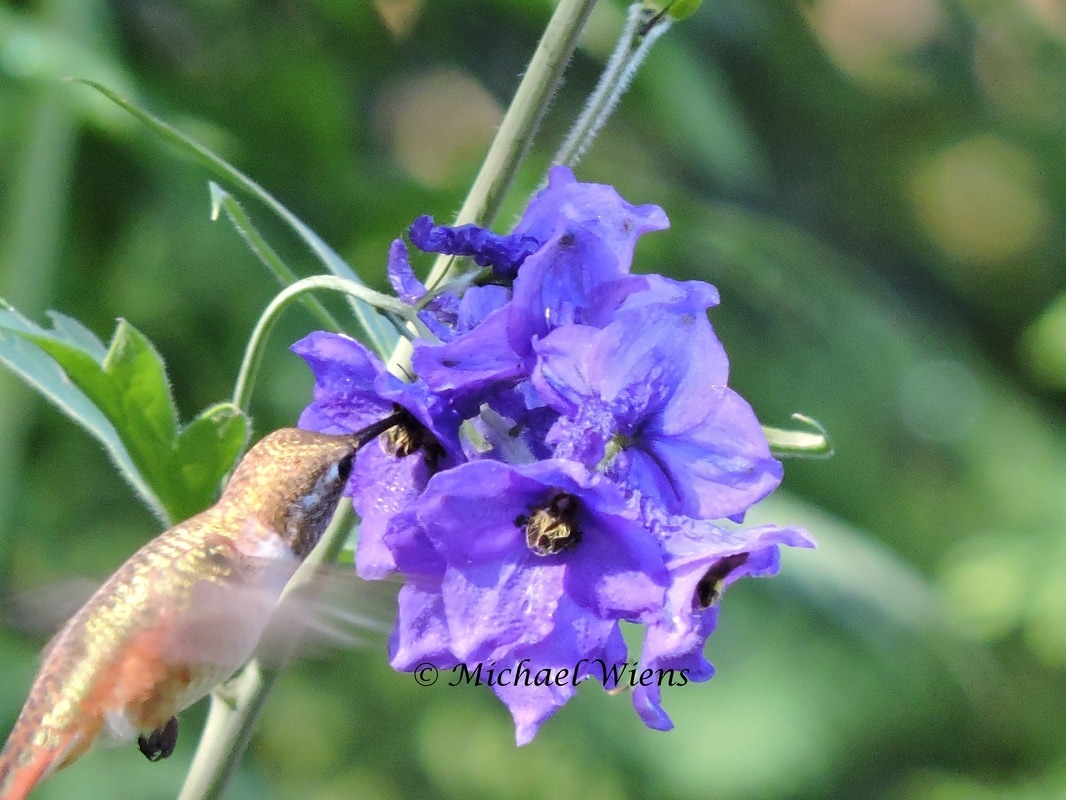 For those of you that get multiple species of hummingbirds, I seriously envy you. The dominant hummingbird in my region is the Ruby-throat and I consider myself blessed to have just this one type, but when the rare Rufous appears in my yard, life changes dramatically for me. Over the past eight years I've had six years where a Rufous has made one or more appearances. Every year I have full anticipation that another will show up, but that's not always the case. Four of those six years I had a Rufous stop in on the southern migration. One year a beautiful male was the first hummingbird of the season, and another adult male Rufous showed up at the beginning of July a couple years later. I'm a fair distance away from the Rufous Territory, so any time I see one I get just a little bit excited. This last summer I had a juvenile Rufous show up in August. Once you've heard thousands of Ruby-throats, a Rufous sounds noticeably different. A facebook friend described it perfectly as a miniature weed whacker. They have a similar hum to the Ruby Throat, but with a buzz mixed in, and their squeak is a bit different as well. Their bad attitude is similar to that of the Ruby-throat, but with perhaps just a bit more crankiness. Any ways, back to my point. I repeatedly heard an unusual hummingbird in the back corner of our garden. I simply dismissed it as a young Ruby-throat that didn't quite develop its voice. I mentioned this repeatedly to my wife until finally she said, "maybe it's a Rufous". Why didn't I think of that. I slowly walked to the back corner of the garden. As I approached, one hummingbird kept at least a 50 foot distance. I sat still for several minutes until this beautiful copper/olive colored hummingbird started to feed. Man, did I get excited. I snuck back to the house. Well, I guess it was more like a sprint to get my camera. I snuck back to the corner of the garden and got into position. It was a young Rufous, but he was aware of every movement I made. He gave me very few opportunities to snap a picture. When he was done feeding from the flowers he would perch behind me, about 30 feet up. He would cock his head sideways and watch every move I made. I finally managed to get one half decent shot. I was content but hoped to get more opportunities the next day. Unfortunately, he moved on early the next morning. The anticipation is already building for the upcoming season. Will he show up again and perhaps duke it out with Ziggy? Only time will tell. Rufous Hummingbird August 2016, N.E. of Edmonton, Alberta.
1 Comment
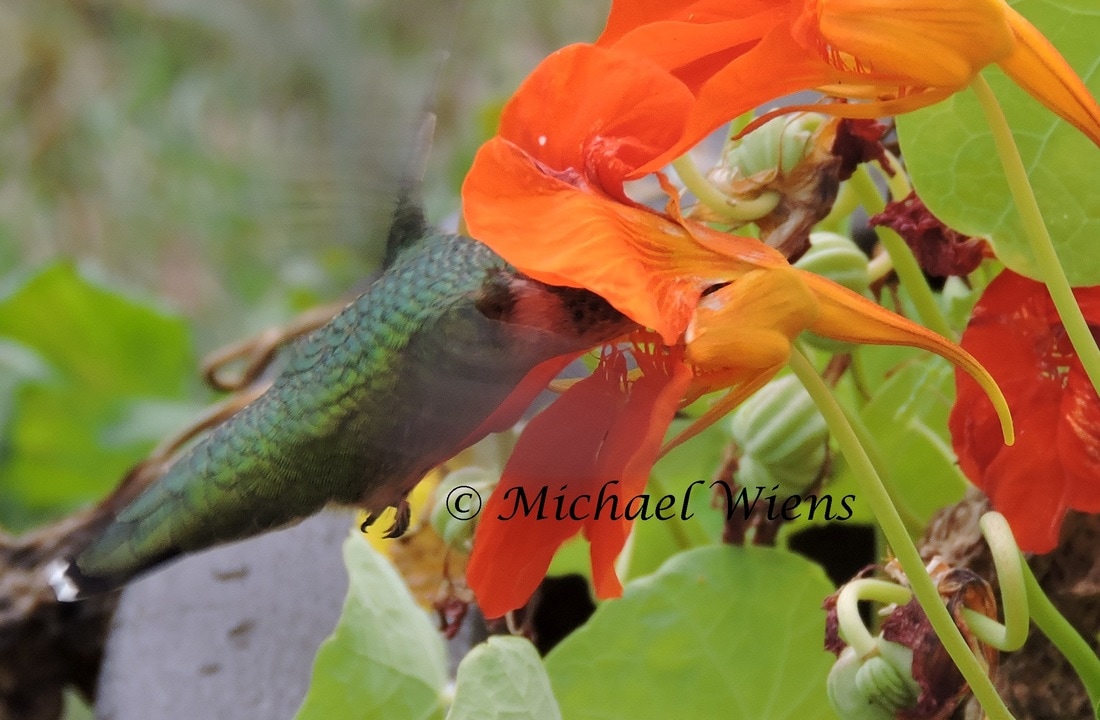 While this young Ruby-throat gets suited up in its hummingbird helmet, it's completely unaware of all the dangers lurking in the flower patch and those from above. Young hummingbirds are incredibly naive to the point that they completely disregard any dangers around them. There are many ground predators that hide amongst the vegetation just waiting for their opportunity, but the vulnerability of young hummingbirds doesn't last very long. They grow quickly and are taught quickly. The adult male and female hummingbirds are quick to teach lessons to those naive young birds. With swift attacks and 60 slaps per second cross the side of the head, those young birds wise up in a hurry. It doesn't take long before they learn how to feed like an adult. They start to withdraw very quickly after they insert their bill in order to see their surrounding. It requires far more energy to feed this way, and they also gain less calories than they normally would, but safety becomes very important very quickly. As for this young bird, all that matters right now are all those bright colours and sweet nectar. Ruby-throated hummingbird, N.E. of Edmonton, Alberta. August 2016. 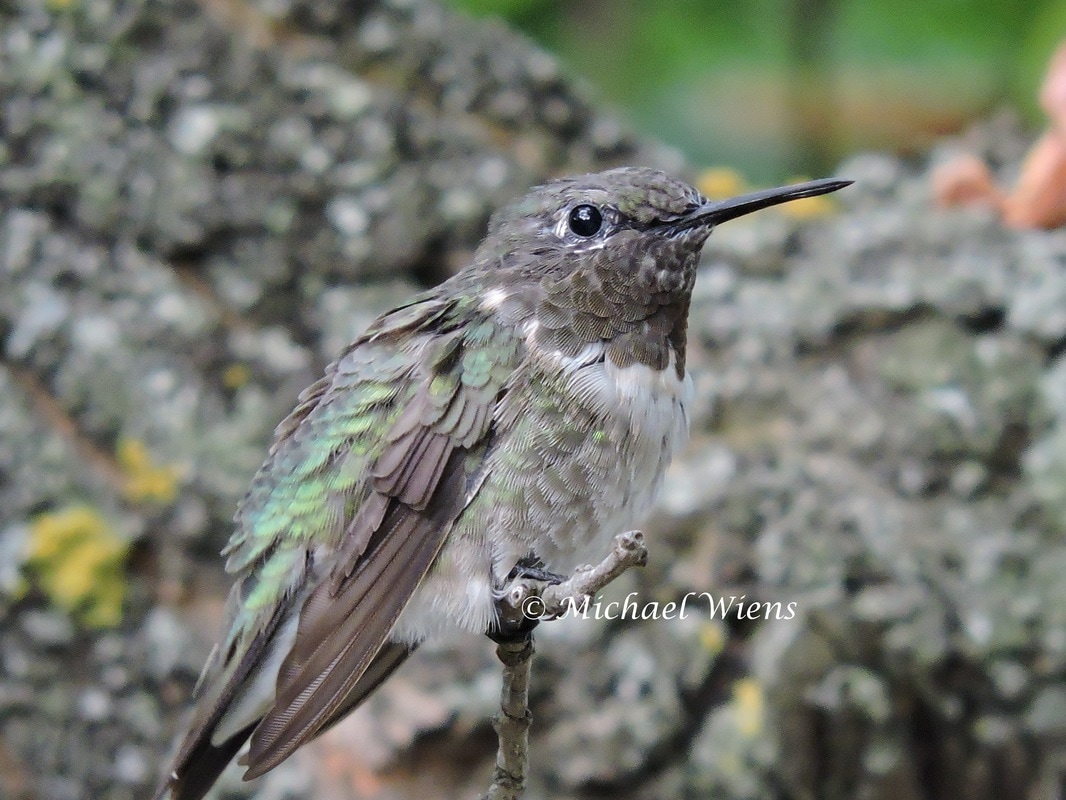 As I scanned through some of last year's photos, I came across this one of an adult male that showed up in our yard mid-migration. It was around the first week in August when several males started appearing. They tend to spend several days feeding and fattening up before continuing on their southern journey. What I saw was not common, but I do see once in awhile. This adult male shows early signs of molting. At the base of his bill and around his eye you can see small pin feathers starting to develop. This is a common process that all birds go through annually. It's a process that usually happens at a lesser time of significance in the year. During breeding season the males are brilliantly colored in order to put on the display of their life. Every feather is in perfect condition during this time in order to impress any possible mates. You just don't see a drab looking male during these times. The times of molt will happen after this significant period of breeding is well completed. During the times of breeding those perfect feathers take a real beating, some torn and badly damaged, while others go completely missing, a lot of this happening due to serious battles among competing males. Although many of us think that the females take on the biggest workload during nesting, breeding takes a serious toll on the males. They put on far more miles than you could possibly imagine during breeding season, and if it's not scouting out newly arriving females, their energy is spent in fierce battles with other males, sometimes costing them their lives. In the end of breeding season, the males will go through a lull of activity. Although they still want to defend their feeders, they restrict their territory to much smaller than it was prior. They begin to gather energy in order to rebuild new feathers for the next time around. Here we have an adult male still protecting his feeder, but limits the amount of time in chase. If it was earlier in the season and another hummingbird showed up at his feeder, his chase wouldn't stop until it reached the next county. But for now, he sits and rests after another season of success. Ruby-throated hummingbird, August 2016, N.E. of Edmonton, Alberta. 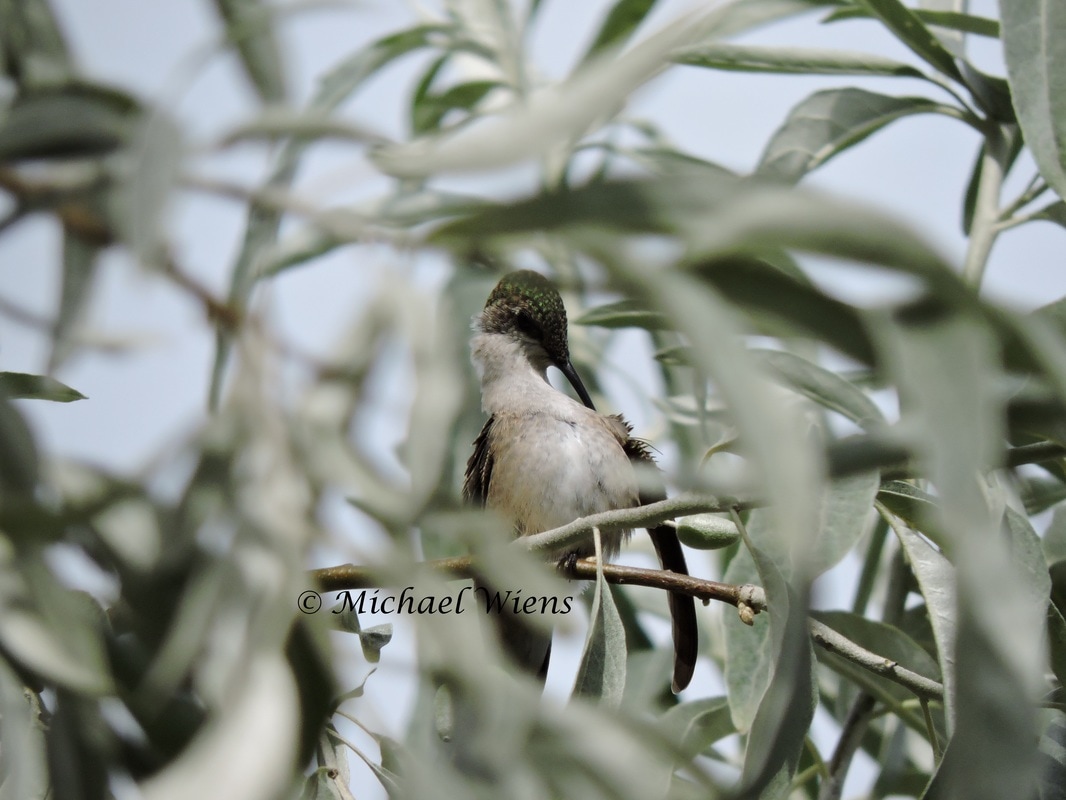 Although many regions of America have a large population of hummingbirds of various species, some regions have reduced numbers. However, many people are under the impression that they are nonexistent in their region. Last summer in Edmonton, Alberta, I carefully tracked how many hummingbirds passed through my yard in just the small number of days that I was around. This is not our hummingbird property, but I'm trying to make a strong effort in attracting them to the city as well. Edmonton is not far from the northern most region of the Ruby-throats' territory, which means the numbers are significantly lower than regions south of here. In saying this, the population is still strong, and if you asked anyone in surrounding areas if they've seen hummingbirds, you'd get a convincing "Yes". The problem with city residents is that they don't believe there's a worthwhile population to put forth the effort in even trying. I will give my city as an example in describing my findings. I don't live near the river valley, but in a populated residential area. If I didn't know any better I would say there would be none around. After seeing countless numbers in the country, I've learned to pick up on their movements quite easily. But in saying this my wife and I oftentimes spot several sightings while the other is busy working in the garden, without the other noticing. Many residents within the same city as myself have told me they've never seen a hummingbird in Edmonton. There's many reasons for that. First, they need a purpose to show up in your yard. Feeders and flowers are a mandatory requirement for attracting hummingbirds. Secondly, would you be able to recognize their movement if you saw one? Those veterans to the hobby would understand exactly what I'm saying when I tell you they've got a unique flight pattern. They don't skip through the air like a Sparrow, they travel similar to that of a Bee, in straight travel mode. The time that people most often recognize them is when they hop from flower to flower, and then easily draw attention to themselves. There was one young male that spent a few days in our yard this last summer. He was one of 8 different hummingbirds that I spotted. He repeatedly flew in and out of our yard, perched up in the tree, sat at the feeders and made himself very obvious. Yet, as I watched him perform his acrobatics around the yard, not one person saw him. People would walk down the sidewalk, neighbors made noise, and traffic was moving all around. He sat in the tree and watched it all going on. He couldn't have made himself more obvious. For 30 second stretches he would hover in the sky feeding on insects. No one noticed. This young Ruby-throat sat in the Russian olive tree and observed its surroundings. It's easy to see how these birds can go unnoticed with how well they disguise into their surroundings. Watch the skies more, and be aware that these birds are far more common than you think. Edmonton, Alberta. 2016 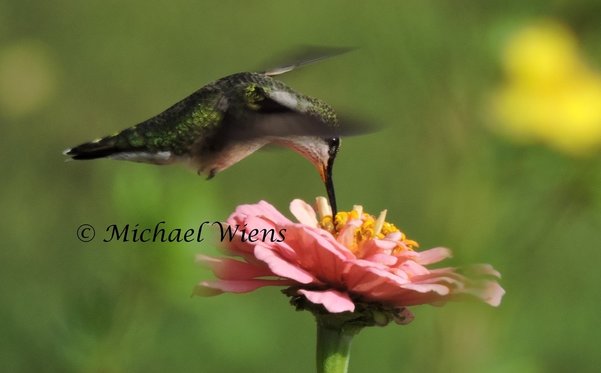 Saturday morning was -17C, but indoors we got comfortable for a garden program that displayed fabulous scenery of the European Countryside. Rolling hills, patchwork of coloured fields, and gardens were simply exploding with colour. As they showed one property after another, it simply inspired us for the upcoming Spring. Roses appeared to be a favourite, but mixed in were Delphiniums, Foxgloves, and an array of flowers completely foreign to my region. It was enough to tease the Spring senses. The country contained everything to complete the perfect garden except for one thing, hummingbirds. Around every corner in the garden there would never be the possibility of spotting one. It somehow lessened the intensity of what a garden could provide. It made me completely aware of the massive blessings that have been sprinkled across the entire continents of the Americas. Well over 300 species of the most fascinating little creatures make their presence across nearly every region and delight gardeners everywhere. These tiny miracles inspire us to no end and encourage us to create beautiful gardens annually. They encourage us to get up at the wee hours of the morning to experience beautiful sunrises, and while we sit anxiously to await their presence, we have the opportunity to appreciate every fine piece of nature along the way. I know there are many like myself who are now counting down the days for the hummingbirds to return. Do I even dare suggest that the Ruby Throat & Rufous residents get even more excited about their return than all the others? With even a more limited time to experience their presence the hype is pretty intense. Could you imagine the excitement from a "bird" or "bloke"? 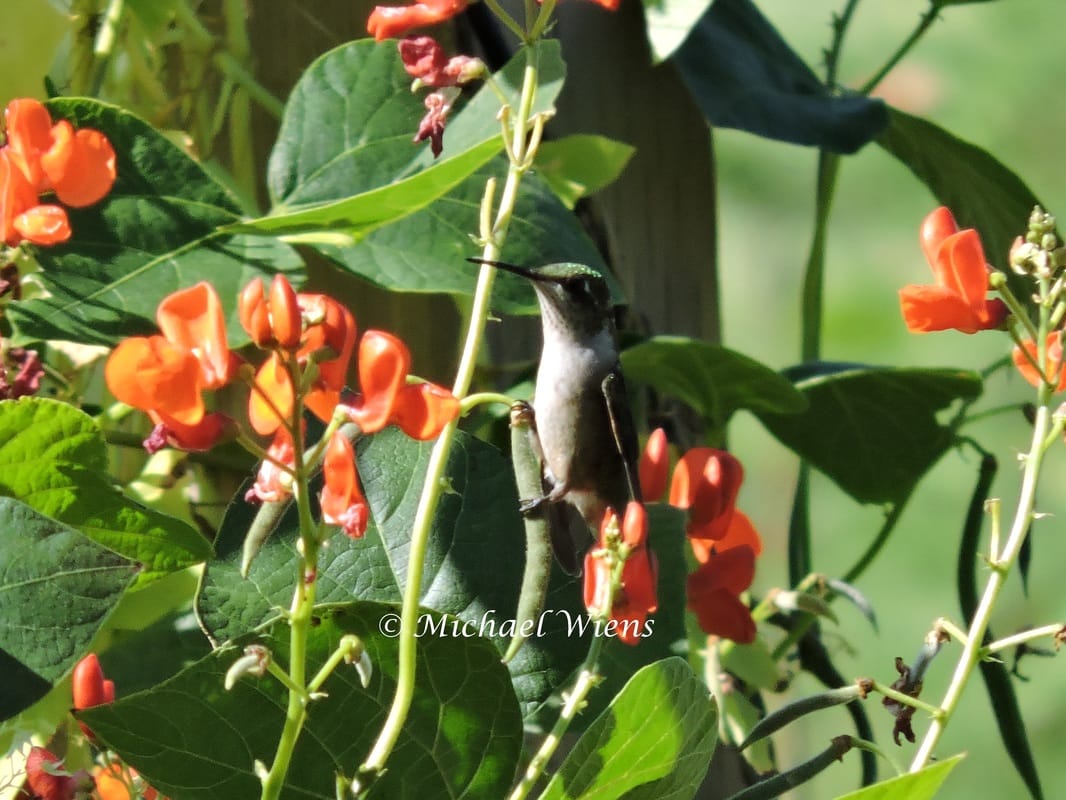 The countdown has begun. For those migrant hummingbird residents heavily reliant on a hummingbird fix, we're only six weeks away from them starting to move north, and eight weeks away from them starting to appear on the Southern U.S. Coast. Right now I'm struggling with why I even live in a climate that reaches -30 Celsius and colder. This isn't the temperature where your tongue just freezes to the metal post, it's the temperature where your tongue falls off before it even reaches the post. So far it's been a very cold winter in my region, but Spring will arrive as it usually does, and many of us are just counting down the days. It may seem a bit early to start thinking about flowers, but in reality many annuals require 12 to 16 weeks if you're starting them from seed until first flower. Depending on the type of system you have set up in your home, it may even take a little bit longer. Many wait until those April urges to start from seed, but then some of your plants may not bloom until well into the season. So right now is the time to consider which annuals need to be started in order to get a good head start for the upcoming season. All plants have their different growing speeds and may not even require starting them indoors. Some flowers shock very easily and don't do very well when transplanted. Personally, I've got a relatively small list that I repeat every year. With trial and error I've determined which annuals are proven hummingbird attractors in my region. I've selected them by how well they flower, how long they flower, and whether the hummingbirds love them. I no longer choose flowers for our benefit, but for the hummingbirds. I want every blooming flower in my garden to be worthy of return visits by our little friends. This is what will separate your garden from all the rest. You may have a garden full of roses, geraniums and poppies, but you'll have very few return visits. And while I talk about good choices of flowers, under no circumstances should you ignore the use of feeders. In springtime when the adult birds are moving north, flowers will get their attention, but feeders are their highest priority. If you've collected seeds over the years, you'll understand the timeframe required in planting them, but if you're new to this you should read the seed packets carefully for planting instructions. Two types of seeds that must be started early are Million Bells and Petunias. They are among the smallest seeds and the slowest growing. It's also a good idea to start them early so that you have colours visible in order to coordinate some kind of planting theme, otherwise it may just be colour chaos, which sometimes looks good and natural. Some seeds just require direct planting, such as Vining Nasturtiums and Scarlet Runners. This young Ruby Throat found a few benefits to the Scarlet Runners. I was wondering where those beans were disappearing to. This was a distant capture of a young Ruby Throated hummingbird who thoroughly enjoyed these flowers. August 2016, N.E. of Edmonton, Alberta. |
Archives
June 2024
Categories
All
|
 RSS Feed
RSS Feed
